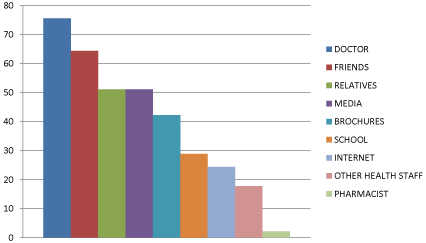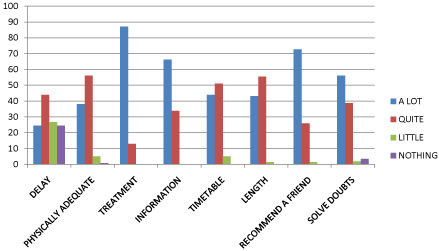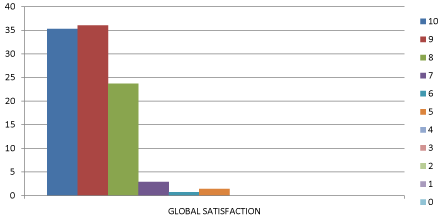Abstract
Aim: Measure the satisfaction level of patients using the Family Planning services in a rural area and determine if there are relationships between satisfaction and other relevant variables.
Methodology: A structured and previously validated (with judge test and pilot test) phone survey to 197 women using the Family Planning Services from October 2011 to October 2012.
Results: Results show a high level of general satisfaction (average score: 8.98, Standard Deviation 1.003), except with the appointment delays. There was no relationship between women using the Family Planning services and the different independent variables (age p=0.392; municipality of origin p= 0.791; employment status p= 0.237; reason of consultation p= 0.613). Patients coming to the office looking for contraceptive methods or contraceptive methods and early diagnosis of cervix cancer are younger than those coming for an early diagnosis of cervix cancer (p< 0,001).
Conclusion: Globally, the satisfaction level of women using the Family Planning service is high. We think there are no relationships between satisfaction and other variables because patients are treated in a very equal way. The low score given to the delay time could be improved if all the health professionals get more involved in providing information and contraceptive assistance in their own work settings.
Keywords: Family planning; Contraceptive methods; Patients’ satisfaction
Introduction
Historically, in Spain, different public institutions and medical specialities (gynaecology, obstetrics, family planning centres, provincial organisms…) used to deal with women problems and reproductive health in a very disrupted and uncoordinated way. Therefore this attention to women was not complete or integral, and therefore they were not treated as a whole.
After the entry into force in 1984 of the Spanish Royal Decree 137/84 on Basic Health Structures, which established basic health areas, health centres and Primary care teams, different health programmes such as the Family Planning were organised. From 1988 the Health Prevention and Promotion Activities Program (PAPPS, Programa de Actividades Preventivas y de Promoción de la Salud) was developed within the primary care services, among these activities is the diagnosis of the cervix cancer [1].
Politically speaking, governments started to decentralise the health competences in a very gradual and unequal way (Catalonia 1981, Andalusia 1984…). This has lead into a heterogeneous offer of women care. More concretely in our region, in Andalusia, the Family Planning program and the early diagnosis of cervix cancer are mainly developed in health centres as part of the daily routine practice.
Since primary care is the first contact of the patient with the health system, the Family Planning service becomes very accessible and tends to be developed in the office with no need of a having a second appointment or a specific consultation.
Depending on the health centre and the involvement of professionals from different health programs, there are times in which women have a programmed or specific consultation in which apart from the contraceptive advice they get, according to PAPPS, cytology. Gathering for the cervix cancer prevention program is normally done in consultations.
For a long time, women in fertile age can choose among different contraceptive methods. Therefore many studies on the characteristics (effectiveness, secondary effects…) of the different methods and compounds have been published. However, the concept of healthcare quality hasn’t been developed completely in this field and the satisfaction level of women using the Family Planning services is not widely known: neither in the ways (consultation, confidentiality, comfort…) nor in the heart of the matter (technical training and information given by the doctor).
It is shown that improving the quality of a Family Planning Service can improve the healthcare quality in other areas of the health services [2] provision. The quality of the Family Planning service is internationally measured using the Bruce-Jein framework which establishes six items: the chance to choose among different contraceptive methods, the information given to patients, the technical knowledge, and the personal relationship with the service provider, the monitoring of the patient and the continuity of the assistance and a right range of services. It has also been valued the fact that the self-assessment tests improve the problem-solving processes and get a greater involvement of the rest of the health staff with this service [3].
At the same time, there are different researches using surveys to describe patients’ satisfaction with the Family Planning services, detect improvement areas and conclude that it is necessary to make more studies and to evaluate the quality of the Family Planning consultations.
The Spanish Society of Contraception has recently made a survey to know the opinion of Spanish women about contraceptives. Using this survey we have elaborated a questionnaire to know our patients’ satisfaction with the Family Planning services.
With this research we expect to know the satisfaction level of those women using the Family Planning services in our health centre and to determine if there is a relationship between this satisfaction and any of the other relevant variables like appointment delays, the adequacy of the office where the service is provided, the manners of the health staff, the suitability of the information given, the timetable of the Family Planning office and the length of the consultation.
Materials and Methods
Population and sample
This study has been carried out using the records of the Family Planning office located in the local health centre of Villanueva de los Castillejos. This service started around two years ago. In this office we take care of patients from: Villanueva de los Castillejos, El Almendro, El Granado and Sanlucar de Guadiana. These are four municipalities that belong to the western area of a region called Andevalo in the province of Huelva. It has a total population of 4,639 inhabitants, 2,380 out of it are men and 2,259 women. It has 426 immigrants (206 women).
The sample of this study is made up of all of the women using the Family Planning services from October 2011 and October 2012: a total of 197 women.
All the women included were invited to take part in the study and those who acceded to participate answered 19 questions during a phone survey about demographic aspects, reasons of consultation, satisfaction with the service and suggestions to improve it [4-8].
Ethical considerations
According to the Spanish Organic Law of Personal Data Protection and the Law of Patients’ Autonomy we proceeded to ask the participants in the study for Informed Consent, in order to make an appropriate use of the information received. This consent was requested verbally and was recorded in the case history of each patient. This project was sent to the Provincial Research Ethics Committee for its evaluation and approval.
Variables
Dependent variable: To measure the level of satisfaction with the service provided we used a questionnaire divided into three parts: personal information, reason of consultation and informative aspects about the development of the consultation, satisfaction level with different aspects of the consultation (appointment delay, physical adequacy of the office, manners of the staff, suitability of the information received, timetable and length) and global satisfaction.
Independent variables: We collected data about the following variables: age, municipality, way of access to consultation, employment status, and contraceptive information source before attending to the office, information provided during the consultation about the different methods and their characteristics.
The questionnaire was filled in by phone and was made up of 19 questions: personal information (questions 1-4), reason of consultation and informative aspects during the development of the consultation (questions 5-9) and satisfaction (questions 10- 18). These evaluate partial satisfaction (questions 10-17) and global satisfaction (question18). All the questions about partial satisfaction were scored using Liker scales, rating from 1 (nothing) to 4 (a lot). Global satisfaction was measured with an ordinal scale from 1 to 10. The questionnaire was validated with a judge test (eight family doctors who provide Family Planning Health Services in other rural health centres) and a pilot test (a phone survey was made and after the Informed Consent the questionnaire was filled in 15 patients). No modifications were needed. Finally, internal consistency was proved with the Cronbach’s alpha test [8-12].
At the end of the questionnaire we included an open question for the patients to evaluate those aspects of the service that could be improved (question 19).
Statistical analysis
Descriptive: For quantitative variables we used the average and the standard deviation.
For qualitative variables, absolute frequencies and percentages.
Inferential: We calculated the confidence intervals.
To determine the relationship among quantitative variables we used the simple linear regression and the correlation coefficient.
To compare both averages we use the t-test for independent samples and to compare more than two averages the Analysis of Variance.
Finally we made a model of multiple linear regression in which the dependent variable was satisfaction level.
In all cases the application conditions were checked.
Results
We were able to contact by phone with 185 women out of the 197 included in the study. 44 of them were excluded for different reasons (Table 1). Finally 139 women completed the questionnaire.
DO NOT ANSWER
23
CANNOT ANSWER
3
DO NOT WANT TO PARTICIPATE
2
DID NOT COME TO THE OFFICE
10
REPEATED / ALREADY ANSWERED
3
WRONG PERSONAL DATA
3
TOTAL LOSSES
44
Table 1: Exclusion reasons.
The average age of patients is 39,63 years (SD 11,83).
Most of the patients (77%) came from the same municipality of the Family planning office. The rest came from near towns.
Most of the patients went to the office on their own initiative (71,2%) and from the office of their family doctor (25,9%).
46% of the interviewed patients work for hire and 25,2% were unemployed.
Regarding the reasons of consultation, 92 (66,2%) came for an early diagnosis of cervix cancer, 21 (15,1%) for contraceptive methods and 24 (17,3%) for both reasons.
Concerning the sources of information about contraceptive methods consulted before coming to the office, most of them admitted to have received this information mainly from their doctors, friends, relatives, and the media. Other sources such as schools, Internet or other health staff were less important (Figure 1).

Figure 1: Information source before the consultation.
60% of the survey respondents came to the office with a clear idea of the method they want to use.
Regarding the information given during the consultation about the different methods, the contraceptive pill was the most requested (91,1%), followed by the vaginal ring (80%) and the intrauterine device (IU, 77,8%). Concerning the information given about every method the scoring is very high in every aspect of this information (88,6%) except from the price (43,2%).
As regards to satisfaction, we have obtained a high level in every aspect evaluated in the study, except from the appointment delays (Figure 2).

Figure 2: Satisfaction level.
Equally, we can highlight the high level of satisfaction with the service provided, with an average score of 8,98 (SD 1,01) (Figure 3).

Figure 3: Global satisfaction.
With respect to the possible relationship between age and satisfaction, after evaluating some applicability criteria, we used linear regression because they are two quantitative variables and we found no relationship between them. We didn’t find statistically relevant relationships between the municipality of origin, the employment status and the reason of consultation with the satisfaction level (Table 2).
Independent variable
Score
Age
p = 0,392
Municipality
p = 0,791
Employment status
p = 0,237
Reason of consultation
p = 0,613
Table 2: Independent variable.
There is a statistically relevant relationship between the age and the reason of consultation: those coming to the office for contraceptive methods or contraceptive methods and early diagnosis of cervix cancer are younger than those coming for just early diagnosis of cervix cancer (s<0,001) [12-16].
During the multivariate analysis done with multiple linear regressions we obtained the results shown in (Table 3).
VARIABLES
Unstandarized coefficients
Significance
Confidence interval for
B at the 95%
B
Typical error
p
Lower limit
Upper limit
9,030
0,470
0,000
8,100
9,960
AGE
0,008
0,007
0,313
0,007
0,022
MUNICIPALITY
0,045
0,109
0,681
0,170
0,260
EMPLOYMENT STATUS
0,131
0,051
0,012
0,232
0,029
REASON OF CONSULTATION
0,042
0,137
0,763
0,313
0,230
Table 3: Multivariate analisys.
Regarding the last question of the questionnaire, about the ways of improving the service provided, there is a relevant negative aspect, which is the excessive appointments delay (40% of the interviewed patients). Additionally they were also worried about the monitoring of the patients and the continuity of the program.
Discussion
This research has been developed in a relatively small sample (44 losses over 197 women included in the study out of 2,259 registered). It has been carried out in a population of women living in a rural area with concrete socio-demographic characteristics. Because of this, results can be extrapolated to other groups with similar characteristics.
Besides, it has to be taken into account that the Family Planning Service in the region where the research has been provided for only two years. This, together with the fact that the survey has been done by phone, could have been a handicap when collecting the data to compare different approaches. At the same time, it can be thought that the shortage of health staff devoted exclusively to this service and the short time they can dedicate to Family Planning services have had a negative effect on having a bigger sample.
The questionnaire used in the study has passed both the judge test and the pilot test and, because it has been filled in by phone, the process of data collecting has been faster. However there have been problems when collecting the information. These were related to the availability and the will of the patients to answer.
Since this is a universal and free service, and because in many cases timely detections happen in the office of the family doctor, the coverage of the risk population increases a lot, both for early detection of cervix cancer and to avoid not wanted pregnancies. However, the activities included the Family Planning program are clearly differentiated from those of early detection of cervix cancer. Having both activities in the same physical space would improve the achievement of goals because accessibility would be favoured and both could be better developed.
The research has shown a high level of satisfaction with the service offered, globally and in the adequacy of the facilities, the manners of the staff and the level of the information provided as well.
We have only obtained a low score in the appointments delay. We think this delay could be partly improved if the family doctor directly offered the family planning services and if the family planning office was saved for those cases requiring more complex techniques or interventions.
This way, the coverage of the program would increase, the access to contraceptive methods would be easier and the number of not wanted pregnancies would be reduced. Logically, this option would require more dedication of family doctors and a continuous update in the knowledge about contraception.
Unlike in other publications [3] we didn’t find relevant differences between the satisfaction level and the different independent variables (age, municipality of origin, employment status and reason of consultation). We think this is very positive because it shows that all the patients have received the same treatment.
We think it is very important to measure the patients’ satisfaction with the service offered, because satisfaction is a very relevant feature of the quality and is very useful to establish corrective actions to get a continuous improvement in quality.
References
- Gervas J, Pérez Fernández M, Palomo L, Pastor R. Veinte años de reforma de la Atención Primaria en España. Valoración para un aprendizaje por acierto/error. Ministerio Sanidady Consumo. 2005.
- Creel L, Sass J, Yinger N. Quality of Care in Reproductive health: definitions and measurements. Quality of Care in Reproductive health: definitions and measurements. Population Reference Bureau. 2002.
- Lynam P, Rabinovitz LM, Shobowale M. Using self-assessment to improve the quality of family planning clinic services. Stud Fam Plann. 1993; 24: 252- 260.
- Nanbakhsh H, Salariak S, Islamloo F, Aglemad S. Assessment of women´s satisfaction with reproductive health services in Urnia University of Medical Sciences. East Mediterr Health J. 2008; 14: 605-614.
- Simbar M, Ahmadi M, Ahmadi G, Majd HR. Quality assessment of family planning services in urban health center of Shahid Beheshti Medical Science University. Int J Health Care Qual Assur Inc Leadersh Health Serv. 2006; 19: 430-442.
- Westaway MS, Viljoen E, Chabalala HP. Satisfaction with family planning services. Interpersonal and organitational dimensions. Curationis. 1998; 21: 3-7.
- Mohammad-Alizadeh S, Marions L, Vahidi R, NIkniaz A, Johansson A, Wahlström R. Quality of family planning services at primary care facilities in an urban area of East Azerbaijan, Iran. Eur J Contracept ReprodHealth Care. 2007; 12: 326-334.
- Erci B. Turkish women´s satisfaction with family planning services. Eur J Contracept Reprod Health Care. 2002; 7; 227-233.
- Kalma S. Measuring university student satisfaction with a campus family planning clinic in Costa Rica. Int J Nurs Stud. 1993; 30: 343-354.
- Hutchinson PL, Do M, Agha S. Measuring client satisfaction and the quality of family planning services: a comparative analysis of public and private health facilities in Tanzania, Kenya and Ghana. BMC Health Serv Res; 2011; 11: 203.
- Kee WF, Swee-Hock S. Knowledge, attitudes, and practice of family planning in Singapore. Stud Fam Plann. 1975; 6: 109-112.
- Fathizadeh N, Salemi P, Ehsanpour S. Dissatisfaction with contraceptive methods. Iran J Nursery Midwifery Res. 2011; 16: 79-82.
- Mayeye FB, Lewis HA, Oguntibeju OO. An assessment of adolescent satisfaction with reproductive primary healthcare services in the Eastern Cape Province; South Africa. West Indian Med J. 2010; 59: 274-279.
- Rejane Ferreira E, Magalhaes da Silva R. Quality of assisted family planning according to opinion of users of a family health program. Acta Paul Enferm. 2006; 19: 150-156.
- Sohail A, Mai D. The quality of family planning services and client satisfaction in the public and private sectors in Kenya. International Journal for Quality in Health Care. 2009; 21: 87-96.
- Sociedad Española de Contracepción [Internet] 2012.
